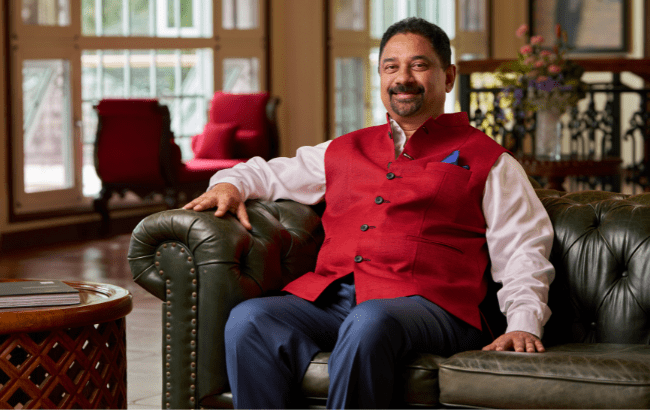Paul John eyes ‘rapid’ growth in India
Although Paul John continues to flourish overseas, India is where the growth opportunity could be biggest due to its younger audience favouring local single malts.

At a recent dinner in London to celebrate the 2024 release of Paul John’s annual Christmas Edition whisky, and taste-test through its portfolio, The Spirits Business sat down with John Distilleries’ head of digital marketing and public relations, Asa Abraham, as well as founder Paul P John to talk about the brand’s latest developments.
Available in 44 countries and rapidly growing, Paul John single malts are making waves internationally, but it’s India, domestically, that is “still our largest market”, Abraham told us.
“I think India, domestically, is going to grow rapidly. It is growing very fast and we find that unlike the rest of the world, the Indian domestic consumer for single malts is actually a little younger than your international consumer,” she explained.
“Because internationally, drinkers may need to pass 35 years or so before they become a ‘seasoned single malt appreciator’, but in India you find that even at the age of 28 or 30, there’s a shift and there’s already a preference to single malt for younger ages. And India’s a very young country. There’s a huge development there. There’s an appreciation of quality.”
Paul John adds that the whisky is expecting more growth and in three years time he “will have to put up another distillery”. The pair note that work has already started on that. Production has also increased at the original Paul John distillery in Goa.
“We started with 2,000 litres of alcohol a day and we doubled it to 4,000 and now we have taken it to 10,000 litres a day of production,” John confirmed.
“We are already running short of some variants, it’s on allocation because of our planning. Whatever we planned six years ago is what we can pull out tomorrow. There are some variants where we have already run out of stock and we are now hoping that we can plan ourselves way ahead, at least six years from now, so that going forward we should not be in this situation.”
Indian whisky demand in UK
Speaking of the UK’s interest in Indian whisky, and world whisky in general, Abraham said that “people here [in the UK] have been drinking Scotch whiskies and traditional craft whiskies for so many years now, that I think they are really opening up and trying new world whiskies.

“Scotch whiskies are mostly elegant and the flavour profile is very defined and very hallowed, but Indian whiskies are a burst of flavour, especially malts. You get a lot of tropical notes, which are different and I think appreciated as well.”
“The UK is a huge market and it also has a very seasoned palate. They know their whiskies. They know their single malts, so if they appreciate our whiskies – we know we’ve ticked the box.”
Paul John single malts are also non-age-statement (NAS) whiskies, which are of interest because they “allow flavour profile to speak instead of the age,” Abraham believes. There are no distractions and primary focus is given to taste.
The tropical climate in Goa means Paul John loses 10% to evaporation on a yearly basis, in comparison to Scotland where it’s 2%. Long ageing isn’t really an option considering how much liquid the distillery loses to evaporation. Even with another Indian distillery in Rampur, which is located further north and with a slightly colder climate, the angels share is not as high.
“Our climate is pretty much 32 degrees throughout the year and it stays tropical through the year,” Abraham adds.
Covering every base
The Christmas edition, which was showcased at the dinner, retails for £60 (US$76) and has an ABV of 46%. The 2024 version was finished in a Caribbean rum cask and vatted with malt matured in a virgin oak cask. Unpeated, it has aromas of mango and pineapple, with coconut, candied orange and dash of toasted oak on the palate. The finish then brings the likes of peach and salted toffee to the fore.
John says that the theme is to “give it the Christmas feel, like a Christmas cake. So when you drink it, that’s what you should be able to taste in the flavour.”
An annual blend – first launched in 2018 – that changes every year. Abraham adds: “We keep it within 7,000-8,000 bottles. It has become a collectors item, so we have a pre-booking system for it. We have people booking in advance, so it has to be good. We’re very privileged that there is demand like this for it.”
Paul John single malt aside, the pair also go through other plans at John Distilleries. The company also has an XO brandy made from distilled grapes and matured for 10 years in French Limousin casks, and is working on a high-end rum that should launch in a few months. Moreover, it produces Original Choice, a blended Indian whisky positioned as the distillery’s “base price product”, of which John says has “sold over 24 million cases this year and is now one of the largest-selling whiskies in the world”.
“He puts his name on our premium spirits, so we have to maintain that…”, Abraham quips.
“But we’re hoping that we have and cover an entire portfolio, so that whatever the requirement is, whichever spirit, we should have a premium offering of that.”
Related news
Top-selling Indian whisky Brand Champions
Diageo India and WSET launch initiative for women
UK-India trade deal ‘changes everything’ for spirits producers
